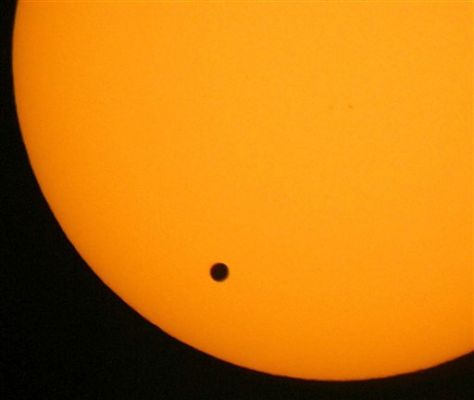Did You Know ?
June 5 : A natural environment wonder is happening on the World Environment Day.
-Compiled by Susan Sharma
Make sure to see the June 5/6 passage of the planet Venus across the face of the sun: a similar event won't happen again until the year 2117. Catch transit of Venus now, or wait another 100 years.
It's so unique that museums and schools around the globe are hosting Venus viewing festivities — all for a chance to see our star sport a fleeting beauty mark. Venus will appear as a small black dot gliding across the disk of the sun. As in a solar eclipse,
do not stare directly at the sun; wear special protective glasses.

Photo credit: AP | This June 8, 2004 file photo showing the transit of Venus, which occurs when the planet Venus passes between the Earth and the Sun, was taken from Hong Kong. Venus will cross the face of the sun on Tuesday June 5, 2012, a sight that will
be visible from parts of Earth.
Here is what the Nehru Planetarium in new Delhi has to say about this terrestrial event.
"There is worldwide excitement awaiting the Transit of Venus across the disk of the Sun as will be witnessed on the 5th/6th of June 2012. Well ahead of that, in the coming weeks, the planet Venus will be seen with increasing brightness descending rapidly towards
the Sun, and later, slowly disappearing in its glare. Everyone would have had seen Venus at its best these days – dominating the western skies with its dazzling brilliance.
Something a little strange about it, may or may not have been noticed. This strangeness is a recurring phenomenon with Venus, well known since its first discernment by Galileo, who was the first to turn a telescope towards celestial objects. As Venus becomes
brighter, through its appearing nearer and nearer to the Earth in its orbit around the Sun, it becomes thinner and thinner – at its brightest, Venus will be just a thin crescent – something which is discernable only when it is viewed through a telescope.
For people interested in the history of astronomy, and in particular from an Indian perspective, it would be quite intriguing to note that there are some possible mentions of phases of Venus in a 17th century treatise on astronomy, in India. This is the Siddhanta
Tattva Viveka of Kamalakara, from Varanasi, thought to have been published around 1658. There are several shloka in this treatise where Kamalakara refers to the fact that Venus becomes thinner as it becomes brighter. It would be very fruitful to initiate a
closer look at atronomical understanding and observations in the 17th century, from India. (Article by N. Rathnasree, B. S. Shylaja, Geetha Kaidala and Amitabh Mukherjee, submitted to Current Science)
To allow citizens of Delhi a view of the crescent Venus, a skywatch is being organized by the Nehru Planetarium, Nehru Memorial Museum and Library. Some telescopes will be setup at the planetarium on the 4th of May2012, at sunset, and visitors can view not
just the planet Venus, but, also Saturn and Mars and the Moon, though these telescopes.
There is a peculiar poignancy attached with observing Venus at this time, knowing the it is journeying on its way to transiting in front of the Sun – a rare occurrence which none of us now alive will see again, as its next occurrence will be in the year 2117.
The planetarium has prepared a special full dome program about the transit of Venus, which can be seen at 11:30 AM, 3:00 PM and 5:00 PM on this day, to be followed by a discussion session in the planetarium sky theater, about the interesting movements of Venus
in the sky and in its orbit, around the Sun. "
See also this introductory video uploaded by the Planetarium
http://www.youtube.com/watch?v=PDhJcoKNWlA
Coral: Rekindling Venus
To mark the Transit of Venus, the Australian High Commission, in collaboration with the Nehru Planetarium presents a digital film about the world's oceans by Lynette Wallworth. Titled Coral: Rekindling Venus, it will be shown from 6-18 June 2012 in Delhi.
CORAL REKINDLING VENUS is major work for fulldome digital planetariums by acclaimed artist Lynette Wallworth
Australian artist Lynette Wallworth has spent five years making this film, containing remarkable footage of the alien world of coral reefs. The film is a timely reminder of the amazing biodiversity we would lose with even a tiny change in sea temperatures.
See a trailor of the film at
http://youtu.be/cysFRCSM7Nw
Read the full details of the program at our events section
|